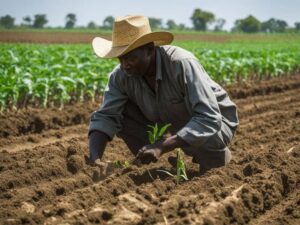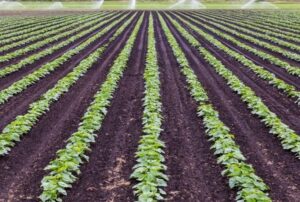Natural Ways to Promote Healthy Chickpea Growth
Chickpeas, scientifically known as Cicer arietinum, are one of the most popular legumes cultivated worldwide. Their versatility in cooking, high nutritional value, and sustainability make them a great crop for home gardeners and commercial farmers alike. If you’re looking to grow healthy chickpeas in an organic or sustainable way, there are several natural practices you can employ to ensure a strong, productive crop. In this blog, we’ll explore natural ways to promote healthy chickpea growth, focusing on soil health, pest control, irrigation, and other essential aspects.
1. Prepare the Soil Naturally
The foundation of healthy chickpea growth starts with healthy soil. Chickpeas thrive in well-drained, fertile soil with a slightly alkaline pH between 6.0 and 7.5. Here’s how you can naturally prepare the soil:
- Soil Testing: Begin by testing your soil’s pH and nutrient levels. This helps you determine what amendments are necessary. Natural soil tests are available, and they provide insight into soil composition, which can guide you in balancing its nutrients.
- Compost and Organic Matter: Incorporate plenty of organic matter into the soil. Compost, aged manure, or other organic amendments can increase soil fertility, improve drainage, and promote beneficial microbial activity. Chickpeas benefit from soil rich in organic matter, which helps retain moisture while also preventing the soil from becoming compacted.
- Crop Rotation and Cover Cropping: Chickpeas are legumes, meaning they have the ability to fix nitrogen in the soil through a symbiotic relationship with rhizobium bacteria. This reduces the need for chemical fertilizers. To maintain soil health, practice crop rotation by planting chickpeas in different areas each season. Additionally, use cover crops like clover or legumes that can add nitrogen to the soil during off-seasons.

2. Choose the Right Chickpea Varieties
Selecting the right chickpea variety for your region and soil is an important factor in ensuring healthy growth. Ensuring optimal soil health with natural amendments, fostering biodiversity, and practicing thoughtful crop rotation are integral to fortifying the resilience and vitality of chickpea plants. This holistic approach not only promotes the well-being of the crops but also contributes to the conservation of the ecosystem, highlighting the profound synergy between organic natural farming and fostering healthy chickpea growth.
There are two primary types of chickpeas: desi and kabuli.
- Desi Chickpeas: These are smaller and darker, with a rougher coat. They are more drought-resistant and tend to perform better in dry, hot climates. If you’re in a region with lower rainfall, desi chickpeas are an ideal choice.
- Kabuli Chickpeas: These are larger, lighter-colored, and have a smoother skin. They require more moisture and are best suited for areas with moderate rainfall or irrigation.
By selecting a variety that matches your climate and soil conditions, you can naturally boost the chances of successful chickpea growth.
3. Proper Planting and Spacing
Planting your chickpeas correctly is essential to their overall health. Chickpeas prefer a warm climate, with optimal temperatures between 70°F and 85°F (21°C to 29°C). However, they can tolerate a range of temperatures, as long as there’s no frost.
- Planting Depth and Spacing: Plant chickpea seeds about 1-2 inches deep in well-prepared soil. Ensure that you space them 6-8 inches apart to allow adequate air circulation and root growth. If planting in rows, space the rows 18-24 inches apart. Proper spacing helps prevent overcrowding, which can lead to poor air circulation and increased susceptibility to disease.
- Timing: Chickpeas are a cool-season crop and should be planted after the last frost of the spring. In warmer climates, plant them early in the season to avoid high summer temperatures, which can reduce yield.
4. Watering with Care
Chickpeas have moderate water requirements, and overwatering can be just as damaging as underwatering. To promote healthy growth, it’s essential to irrigate your chickpeas appropriately.
- Consistent Moisture: Keep the soil consistently moist, especially during germination and the flowering stages. Once the plants mature, they can tolerate drought conditions, but they still need adequate water during early growth. Using a drip irrigation system or soaker hoses can provide a steady, consistent supply of moisture to the roots without oversaturating the soil.
- Water Conservation: If you’re growing chickpeas in areas with low rainfall, water conservation techniques such as mulching can help retain soil moisture. Organic mulch like straw or grass clippings will also add nutrients to the soil as it decomposes.
- Avoid Waterlogging: Ensure that the soil drains well, as chickpeas do not thrive in waterlogged conditions. Poor drainage can lead to root rot and other diseases. If your soil has drainage issues, consider planting on raised beds to prevent the roots from sitting in standing water.
5. Natural Pest and Disease Control
Chickpeas, like any other crops, are susceptible to pests and diseases. However, instead of resorting to harmful chemical pesticides, there are various natural methods to manage these threats.
- Neem Oil: Neem oil is a natural pesticide that can be used to control aphids, whiteflies, and other insect pests. It’s non-toxic to humans and beneficial insects, making it an excellent choice for organic gardening.
- Insecticidal Soap: Another natural option for pest control is insecticidal soap, which can be used to treat aphids, caterpillars, and other pests. These soaps are effective against soft-bodied insects and won’t harm the environment or beneficial insects like bees and ladybugs.
- Beneficial Insects: Introduce beneficial insects like ladybugs, lacewings, and predatory beetles to your garden. These insects naturally control pest populations by feeding on harmful insects. For example, ladybugs are excellent at controlling aphids, a common pest in chickpea crops.
- Crop Rotation: As mentioned earlier, rotating crops each season helps break the life cycle of many pests and reduces their chances of establishing a permanent presence in the soil. Avoid planting chickpeas in the same location year after year to minimize the risk of pest infestation.
- Companion Planting: Planting chickpeas alongside certain herbs and flowers can naturally deter pests. For example, garlic, marigolds, and basil are known to repel insects that target chickpeas. Additionally, planting mint or oregano near chickpeas can help improve flavor and deter pests.
- Fungal and Disease Control: Chickpeas are susceptible to fungal diseases like root rot and rust. To prevent these, practice good garden hygiene by removing any infected plants or debris. Avoid watering overhead, which can spread fungal spores, and ensure proper spacing between plants to allow good air circulation.
6. Pruning and Supporting Growth
As chickpeas grow, it’s important to provide proper support to ensure healthy development.
- Staking: Although chickpeas are typically bushy plants, they can benefit from staking or trellising in windy areas. This will keep the plants upright and prevent them from being damaged by wind or heavy rains.
- Pruning: Chickpeas generally don’t require much pruning, but removing dead or damaged stems can help reduce disease and improve airflow. Additionally, if the plants are growing too densely, thinning them out slightly can help promote better growth.
7. Harvesting at the Right Time
Finally, it’s essential to harvest your chickpeas at the right time to ensure the best flavor and yield. Chickpeas are usually ready for harvest when the pods turn yellow and the seeds inside rattle when shaken. If you wait too long, the seeds may become hard and lose their flavor. Harvest in dry weather and allow the chickpeas to air-dry before storing them in a cool, dry place.
Conclusion
Growing healthy chickpeas naturally requires a combination of good soil management, proper planting practices, natural pest control, and careful attention to irrigation and pruning. By using these sustainable techniques, you can enjoy a high-quality, healthy chickpea crop without relying on synthetic chemicals. Chickpeas are not only a delicious and nutritious food source but also an environmentally friendly crop to grow, as they fix nitrogen in the soil and reduce the need for artificial fertilizers. By applying these natural methods, you can promote healthy chickpea growth and contribute to a more sustainable gardening or farming practice.














Post Comment